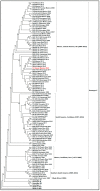Characterization of a Dengue Virus Serotype 1 Isolated from a Patient in Ciudad Juarez, Mexico
- PMID: 34358022
- PMCID: PMC8308707
- DOI: 10.3390/pathogens10070872
Characterization of a Dengue Virus Serotype 1 Isolated from a Patient in Ciudad Juarez, Mexico
Abstract
Dengue (DEN) is the most important human arboviral disease worldwide. Sporadic outbreaks of DEN have been reported since 1980 in urban communities located along the border in southeast Texas and northern Mexico. Other than the Rio Grande Valley region of TX, autochthonous transmission of DENV has not been reported from any other US border communities. As part of a surveillance program for arthropod-borne viruses in Ciudad Juarez, Mexico, during November 2015, a blood sample was obtained from a female patient who experienced an undifferentiated fever and arthralgia. The plasma of the sample was tested for virus in Vero-76 and C6/36 cells. DENV serotype 1 (DENV-1) was isolated in the C6/36 cells, and nucleotide sequencing of the envelope gene and full genome grouped the DENV-1 isolate in the Central America clade. The patient had not traveled outside of Ciudad Juarez, Mexico, thus suggesting DENV-1 infection was acquired in this community.
Keywords: Central America clade; Mexico; dengue virus.
Conflict of interest statement
The authors declare no conflict of interest. The funders had no role in the design of the study; in the collection, analyses, or interpretation of data; in the writing of the manuscript, or in the decision to publish the results.
Figures





References
-
- De la Mora-Covarrubias A., Jiménez-Vega F., Treviño-Aguilar S.M. Geospatial distribution and detection of dengue virus in Aedes (Stegomyia) aegypti mosquitos in Ciudad Juárez, Chihuahua, Mexico. Salud Publica Mex. 2010;52:127–133. - PubMed
Grants and funding
LinkOut - more resources
Full Text Sources
Research Materials

